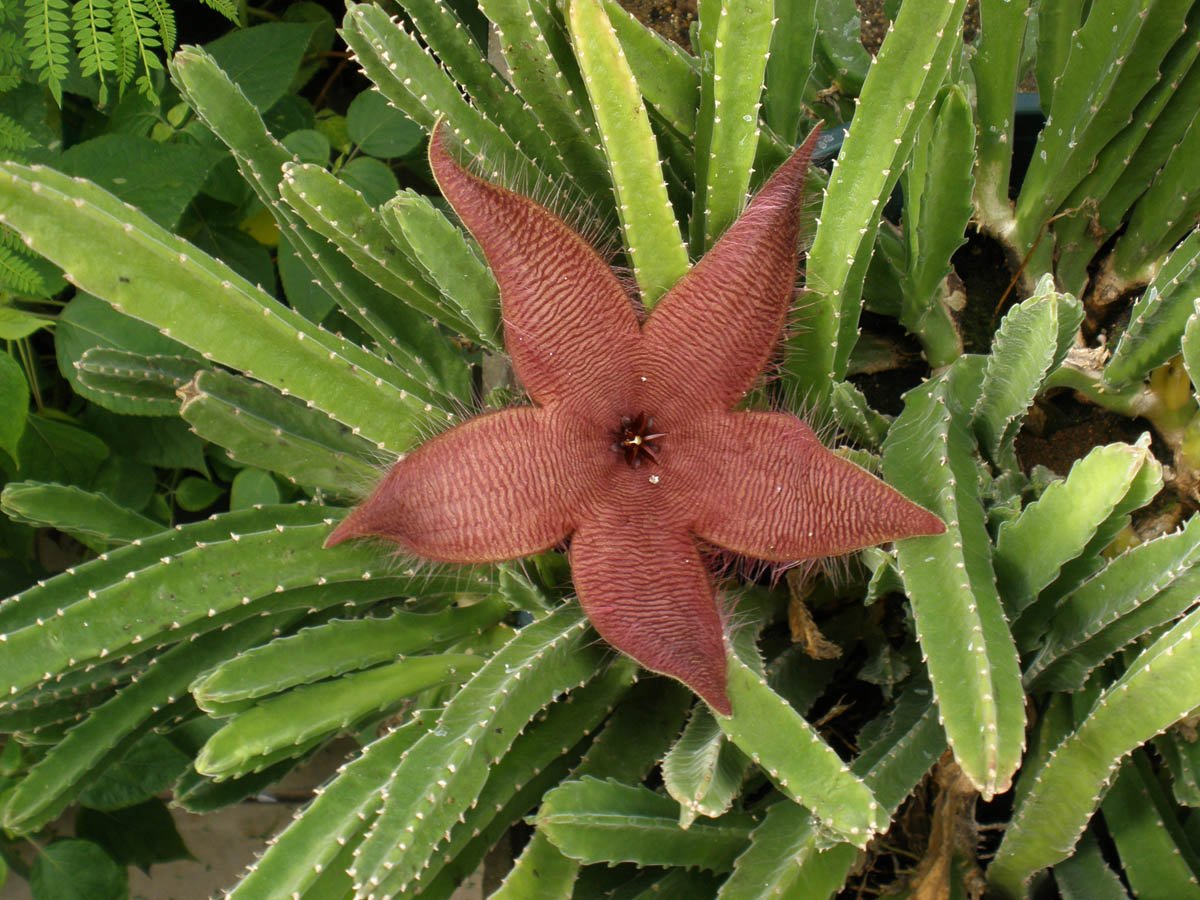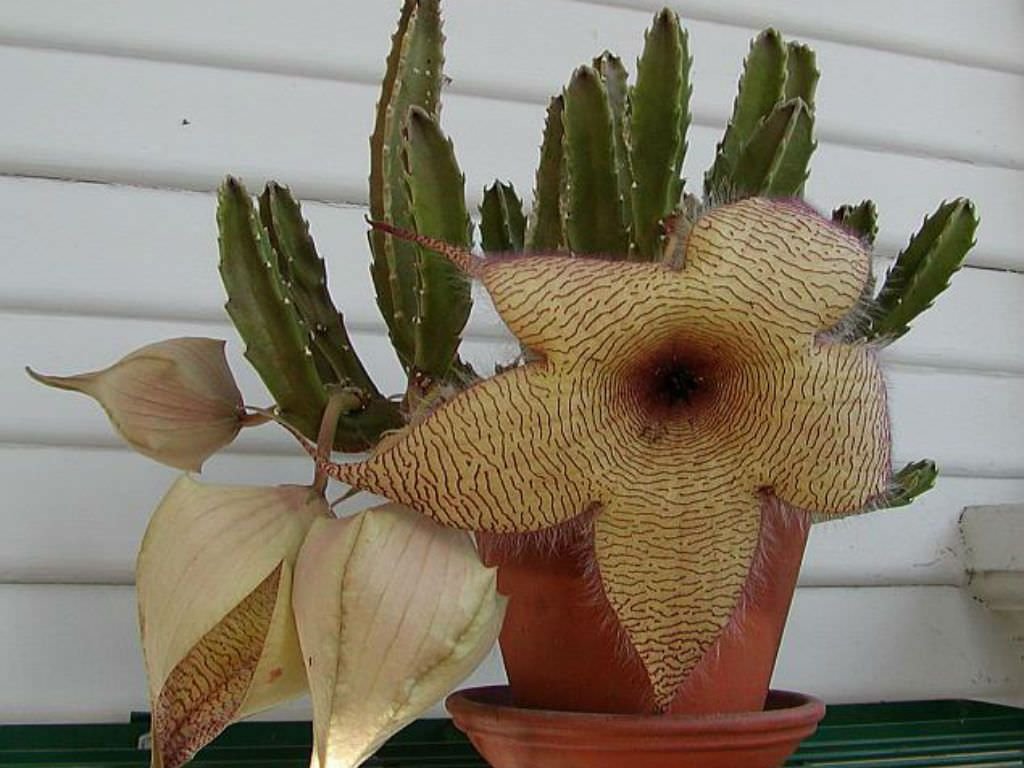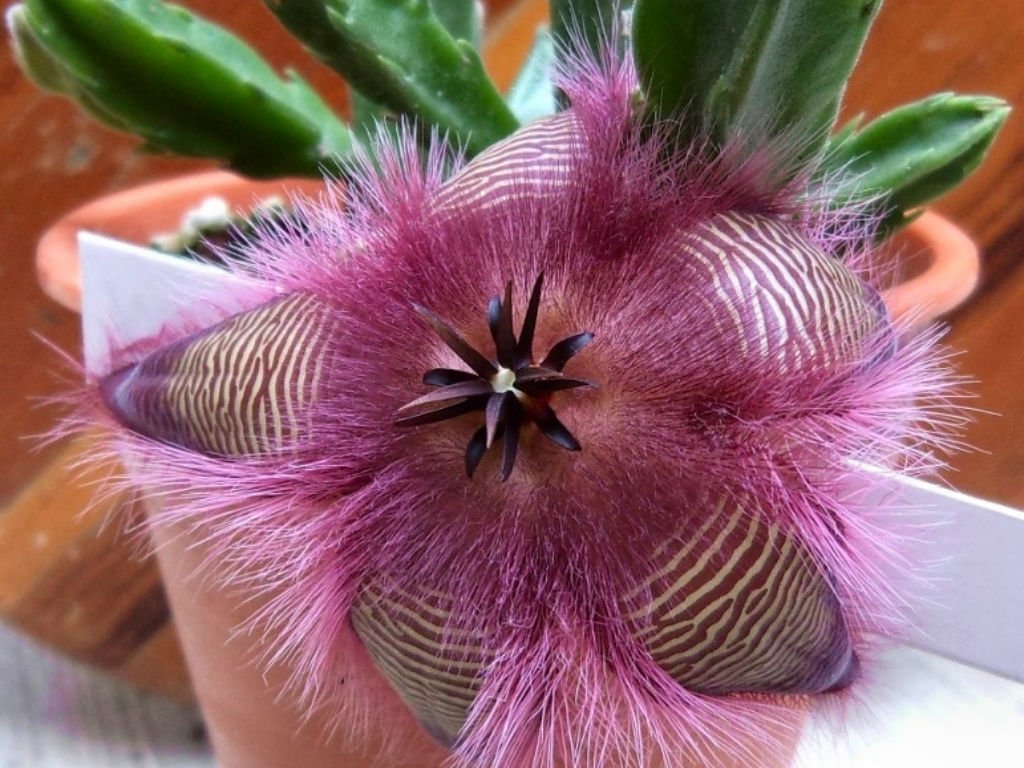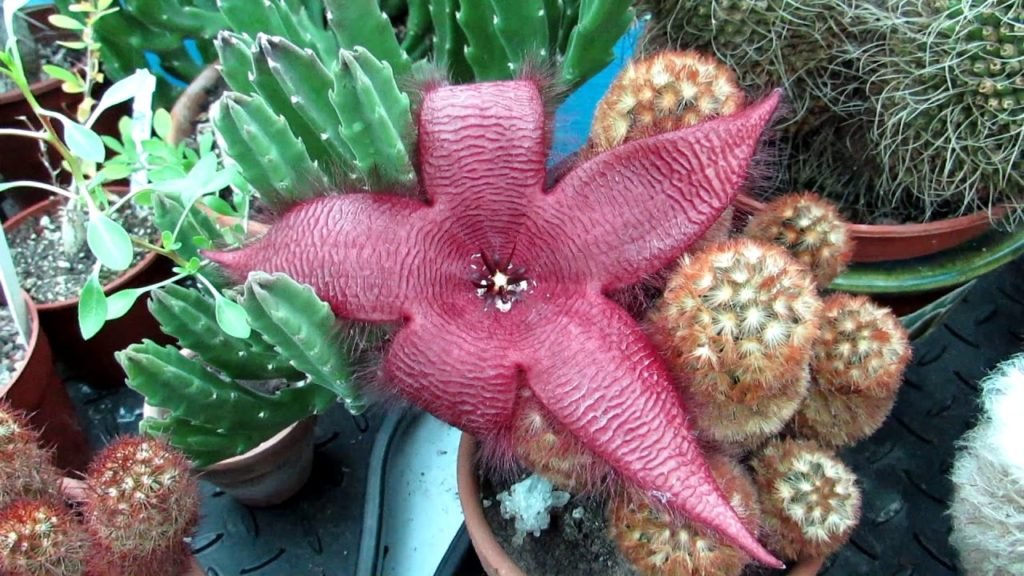Starfish Cactus is an attractive and uncommon creation on land. The Stinky Plant partially falls in the category of Cactus and is a unique attractive flowering plant.
The common scientific name of the Carrion Plant is, Stapelia Grandiflora. Furthermore, These plants possess other names according to their specialty as, Carrion Plants, Starfish Flower Cactus, Rotten Plant, and Stinking Cactus.
These plants contain thick fleshy tissues of water storage. Therefore, comes under the ‘Succulent Group Of Plants’.
The Carrion Plant grows up to 9 – 10 cm in diameter either straight or curved, These plants grow with soft stems without spines spreading through the center and are usually hairy.
Unique Characteristic Of A Starfish Cactus
In addition, The plant naturally grows in the tropical regions of South Africa, the Eastern Cape, and the Free States. These flowers consist of different colors such as; Pink, Orange, Red, or Mixed.
Usually, these succulent plant owns about 5 petaled flowers and emit some rotten smell.
How Does Starfish Cactus Smell?
The Stapelia Grandiflora owns an unpleasant odor. As a result, it emits an unpleasant smell like rotten meat.
Subsequently, The Smelly Succulent attracts flies, and pollination takes place easily with the help of the flies.
Moreover, If the succulent begins to smell, then there is a possibility you will not be able to save your plant as the rotting smell indicates that the plant and its roots are being spoiled. The smell of succulent rot is much like mold and the smell of cactus rot is similar to rancid peanut butter.
Different Species Of The Starfish Cactus
1. Stapelia Grandiflora

In addition, These species of Starfish Cactus grow up to 70 inches in height and they own very long and slim stems. The Stinky Cactus cover themselves with smooth velvety fur.
2. Stapelia Gigantea

The species of Gigantea are the largest flowers and they grow appropriately for 8 inches in height. These flowers are in the shade of yellow with thin red stripes.
3. Stapelia Variegata

It grows up to 6 inches in height and Specially, Stinky Cactus own pretty yellow flowers with purplish-brown patterns.
These varieties of Stinky Cactus bloom across 2 to 3 inches.
4. Stapelia Hirsuta

Cacti plants are slimmer than the Stapelia Variegata and these types of Stinky Cactus consist of long furry stems and grow about 8 inches high.
The word “Hirsuta” means “Hairy”. Consequently, ‘Hairy Starfish Cactus‘ is the name for Stinky Cactus Variety.
Uniquely, These flowers are purplish-brown with yellow stripes. In addition, their Hairy flora blooms across 4 to 5 inches.
Stapelia Grandiflora vs Stapelia Gigantea
The different terms are known as, Stapelia Grandiflora vs Stapelia Gigantea confused as if, the same or different?
So, Stapelia Gigantea and Stapelia Grandiflora are in the same Apocynaceae family. The only difference is their structure shape and size.
Stapelia Grandiflora is a species of Starfish Cactus. While Stapelia Gigantea is in the related name or nickname.
However, Carrion Plant consists of 4 varieties- Two of the varieties Stapelia Grandiflora and Stapelia Gigantea with slight differences in shape and size.
Likewise, The flowers of Stapelia Gigantea are much larger than the flowers of Stapelia Grandiflora.
But, both the variety on the same propagation method of seedling or cutting Propagation method.
How To Care For A Starfish Cactus
These are a few necessary points to keep in mind when caring about starfish cactus.
1. Sunlight
Sunlight is an important source of energy for the survival of the Carrion Plant. These succulent plants need enough amounts of indirect sunlight and brightness. The Starfish succulents need protection from direct sunlight.
2. Temperature
For the survival of any living organism, the temperature is important so, as for the Starfish Cactus. It requires a warm temperature above 50° degrees in the wintertime. The plant does not bear a temperature below 10°c (50°F) for an extended time period.
Grow lights can be used to soothe the plant.
3. Humidity
Humidity is another word for ‘moisture’. It is the number of water particles present in the air. Which is also a requirement. The Stapelia Grandiflora does not need too much moisture for survival as the plant is moistened naturally.
4. Potting
The springtime before its growing season is the best period for Starfish Cactus potting. These planting pot needs to be wide and low in height. where the Stinky Cactus has enough space to spread.
It is also important to place some hard layers like pebbles at the bottom of the pot to provide proper sewerage.
4. Watering Recommendation
Another source of survival for living organisms is water. Starfish Cactus also need the correct amount of water all the time.
It is recommended to water once a week, for 10 days, allowing the soil to completely dry out in between waterings.
Learn more about how to water cactus and succulents.
5. Soil
It is important to select the correct type of soil for the growth of Stapelia Grandiflora.
Suppose the plant grows naturally in a warm area, its natural habitat is in the right soil. But, if the plant is grown indoors then the soil type needs to be chosen. Most Succulent Plants like; Light, Airy, and well-drained soil.
6. Fertilizer
Although the Starfish Cactus does not need any fertilizer if the Carrion Plant is grown indoors then, fertilizer needs to be provided.
The Fertilizer which contains higher Prosperous than Nitrogen should be half diluted.
Starfish Cactus Propagation
‘Propagation’ defines the growth of new plants for any source.
The 2 techniques of Propagation are following.
1. Starfish Flower Cactus Seedling Method
- If the rotten smell of the plant can be tolerated then, the Starfish Cactus flowers need to be put to dry.
- In addition, the seeds can be formed for propagation after the flowers are dried off.
- The (Stapelia Grandiflora) Starfish Flower Cactus should be planted in a warm area.
2. Starfish Flower Cactus Cutting Method
An easy strategy to propagate Starfish Cactus the cutting technique;
• Cut 3-4 inches of stem.
• pierce the callus (soft tissue of root growth) at 45°c.
• Allow the slit stem of the Stapelia Grandiflora to dry before it is planted in individual pots.
• The pots need to be planted under low sunlight and with average moisture.
• When the Starfish Cactus begins to grow into a baby plant then it should be repotted.
• This cutting propagation method decreases the Stinky smell of the Succulent Plant.
Repotting Of Starfish Cactus
A relevant practice that needs when Stapelia Grandiflora is grown is, “Repotting”. To clarify, the Starfish Cactus has matured, it needed the plant with more space.
Then, the potted Carrion Plant is planted in another pot with wider and deeper space. The repotting technique of Starfish Cactus has developed as a trend today. In other words, many people spend money to buy these Succulent Plants to beautify their homes or outer environment.
Today, Stapelia Grandiflora is purchased very easily through online boutiques. Such as Amazing, eBay, etc.
The given link is the web portal to buy Stapelia Grandiflora plants on Amazon
How Often Do Starfish Cactus Bloom?

Stapelia Grandiflora bloom time depends on its habitat. The blooming time relies on the amount of Sunlight, Water and Temperature received.
Approximately, a baby Starfish Cactus blooms in 2 years with one or two flowers.
Often, Starfish Cactus blooms successfully in July to September in North America when the Carrion Plant grows mature.
In South Africa, the Starfish Cactus flower blooms from November up to March. These are native Carrion Plants.
But, the blooming period is rare to identify as the growing condition differs.
Find here the 20 popular flowering succulents.
Disease and Pest Control of Stapelia Grandiflora
“Disease” is an abnormal condition that affects the functions of any living organism.
“Pests” are small organisms that destroy plants or animals. So, Pest Controlling strategies need to be provided for protection.
These are common diseases for the cactus.
1. Stapelia Turning Yellow
This is the initial stage of a fungal attack. When the Stapelia Grandiflora is affected through scarcity of water and nutrients of the Succulent Plant turns yellow.
2. Stapelia Turning Purple
This is also a fungal attack of Starfish Cactus where the plant turns Purple.
When the plant has signs of stress. That occurs due to high temperature, excessive sunlight, or less water.
Disease Control:
Such condition can be controlled if adequate amounts of water and sunlight is provided.
3. Stapelia Turning Brown
Above all, The final stage and most severe stage of the Starfish cactus health issue.
When Stapelia does not get enough water, sunlight, and proper temperature for a long time. The Carrion Plant turns Brown which is about to dry out or die.
Disease Control:
If the Starfish Cactus turn completely dry and turn Brown then, the plant cannot be saved.
4. Stapelia Turning Black
This is a dangerous fungal disease including Bacterial Necrosis, Phyllosticta Pad Spotting, and Crown Rot.
As a result, the Succulent Plant begins to have black spots on the surfaces then, the Starfish Cactus turns black and mushy.
Disease Control:
When the plant is in the initial stage then clean the affected areas or cut that portion.
But, if the disease had spread all over the Succulent Plant then, the Plant cannot be saved. In very rare cases only the Plant can be saved.
Pest Attacks Caused In The Starfish Cactus
Below are a few diseases from this cactus.
1. Red Spider Mite
This is a harsh pest attack on the Starfish Cactus.
When the plant is afflicted, the plant begins to get yellow stippling on the stem with tiny dots.
Pest Control:
Wipe the color-changed area with water or Isopropyl Alcohol with a cotton ball.
This cleaning tactic needs to be repeated several times.
If the cleaning tactic is unsuccessful then, Miticide Products (Chemical pesticides) should be used.
2. Scale Insects and Mealybugs Bugs
When the Starfish Cactus is raided by the mealybugs, this affects the growth function of the plant.
Pest Control:
Use a sharp object to scrape the bugs off or wipe the affected areas with tongs or pluckers.
If the pest effect is severe then, Neem Oil or Insecticidal Soaps need to be used.
Toxicity of Starfish Cactus to Pets and Children
Every plant species is toxic to some living beings and non-toxic to other organisms. The Starfish Cactus is non-toxic to pets like; Dogs, Cats, and Horses.
The Starfish Cactus is toxic to children. These Stapelia Toxic will cause health issues to kids if they inhale or touch the succulent plant for a long time.
Find more about the succulents and cacti that are poisonous to dog, cat, and pets.
Summary
Stapelia Grandiflora is a special species of plant that grows in many places. The structure, size, and special features of ‘Stinky Cactus Smell’ makes the Succulent Plant more unique.
The uncommon and beautiful nature of the Succulent Plant attracts many people to demand these plants.
The Starfish Cactus exposes a posh look to the environment. Starfish Cactus need proper care if the plant is grown indoors. More attention concerning the pot area and sewerage system is needed when the plant is repotted.
Rather than, the seedling Propagation method of Starfish Cactus, the cutting transmission approach is more easier and successful.
Carrion Plant that is planted according to the blooming time period will grow favorably. The plant needs protection at the initial stage as Stapelia Grandiflora contains diseases and pest attacks.
Stinky Cactus is Toxic to children in contrast, non-toxic to pets. Stapelia plant makes the environment look beautiful and awesome.
In Conclusion, Hope that the above information regarding the Succulent Plant is supportive to enhance knowledge concerning this special gardening plant.
Gardening Today – Fruitful Tomorrow!



